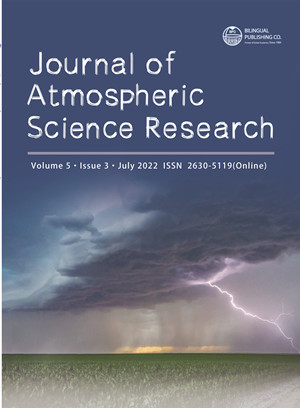-
2081
-
1501
-
1495
-
1366
-
1230
Asymmetric Mean Annual Temperature Wavelets Surface Air Layer of Berlin for 1701–2021
DOI:
https://doi.org/10.30564/jasr.v5i3.4674Abstract
The regularities of the dynamics of the average annual temperature of Berlin from 1701 to 2021 are revealed. A total of 65 wavelets were received. The temperature has a high quantum certainty, and the change in the average annual temperature of Berlin was identified by a model that contains only two components for prediction. The basis of the forecast at 320 years makes it possible to look into the future until the year 2340. The forecast confirms the conclusions made in the CMIP5 report on global warming. With an increase in the number of components in the model up to five, the forecast is possible only until 2060. Therefore, the model with only two components is workable. The trend is characterized by a modified Mandelbrot equation showing exponential growth with a high growth rate of 1.47421. The wave equation also has an amplitude in the form of the Mandelbrot law (in mathematics, the Laplace law, in biology, the Zipf-Pearl law, in econometrics, the Pareto law), when the exponential growth activity is equal to 1. For 1701, the period of oscillation was 2× 60.33333 ≈ 120.7 years. By 2021, the period decreased and became equal to 87.6 years. The trend is such that by 2340 the period of oscillation will decrease to 30.2 years. Such an increase in fluctuations indicates an imbalance in climate disturbances in temperature in Berlin. For Berlin, the last three years are characterized by sharp decreases in the average annual temperature from 11.8 °C to 10.5 °C, i.e. by 12.4% in 2021. Therefore, the forecast is still unstable, as a further decrease in the average annual temperature of Berlin in the near future may change the picture of the forecast.
Keywords:
Berlin, Mean annual temperature, 1701–2021, Wavelets, ForecastReferences
[1] Wu, Zh.H., Huang, N.E., Wallace, J.M., et al., 2011. On the time-varying trend in global-mean surface temperature. Climate Dynamics.37(3), 759- 773. DOI: https://doi.org/10.1007/s00382-011-1128-8
[2] Li, Q., Zhang, L., Xu, W., et al., 2017. Comparisons of time series of annual mean surface air temperature for China since the 1900s: observations, model simulations, and extended reanalysis. Bulletin of the American Meteorological Society, 98(4), 699-711. DOI: https://doi.org/10.1175/bams-d-16-0092.1
[3] Ding, J., Cuo, L., Zhang, Y.X., et al., 2018. Monthly and annual temperature extremes and their changes on the Tibetan Plateau and its surroundings during 1963-2015. Scientific reports. DOI: https://doi.org/10.1038/s41598-018-30320-0
[4] Mazurkin, P.M., Kudryashova, A.I., 2019. Quantum meteorology. International Multidisciplinary Scientific GeoConference Surveying Geology and Mining Ecology Management, SGEM. 5(1), 619-627. DOI: https://doi.org/10.5593/sgem2019/5.1/S20.077
[5] Zappalà, D.A., Barreiro, M., Masoller, C., 2018. Quantifying changes in spatial patterns of surface air temperature dynamics over several decades. Earth System Dynamics. 9(2), 383-391. DOI: https://doi.org/10.5194/esd-9-383-2018
[6] Mazurkin, P.M., Kudryashova, A.I., 2019. Urban phytometeorology: influence of the sum of temperatures on the ontogeny of drooping birch leaves. Geographical Bulletin. 4(51), 45-58. (in Russian). DOI: https://doi.org/10.17072/2079-7877-2019-4-45-58
[7] Stouffer, R.J., Hegerl, G., Tett, S., 2000. A Comparison of Surface Air Temperature Variability in Three 1000-Yr Coupled Ocean–Atmosphere Model Integrations. Journal of Climate. 13(3), 513-537.
[8] Kislov, A., Varentsov, M., Gorlach, I.A., et al., 2017. «Heat island» of the Moscow agglomeration and the urban-induced amplification of of global warming. Article in Vestnik MGU. Serija V, Geografia. https://www.researchgate.net/publication/320057275 (in Russian).
[9] Mazurkin, P.M., Wavelet analysis of annual dynamics of maximum temperature from 1878 to 2017 and forecast data Hadley center Central England temperature (Hadcet). International Journal of Current Research. 11(09), 7315-7324. DOI: https://doi.org/10.24941/ijcr.36626.09.2019
[10] Mazurkin, P.M., 2019. Wavelet analysis of the annual dynamics of the average temperature from 1659 to 2017 and forecast according to Hadley center central England temperature (HadCET) data. Exact Science Journal of Natural Sciences. www.t-nauka.ru. Issue. 45. Kemerevo: Pluto Publishing House. pp. 50-65. (in Russian).
[11] Balkhanov, V.K., 2019. Fractal Geometry: Axioms, Fractal Derivative and Its Geometrical Meaning. Journal of Environmental & Earth Sciences. 1(1). DOI: https://doi.org/10.30564/jees.v1i1.475
[12] Zherebcov, G.A., Kovalenko, V.A., Molodyh, S.I., et al., 2013. Influence of solar activity on tropospheric and ocean surface temperatures. News of the Irkutsk State University. Series Earth Sciences. 6(1), 61-79. (in Russian).
[13] Chernokulsky, A., 2022. Will Europe freeze without the Gulf Stream? pp. 46. https://zen.yandex.ru/media/nplus1/zamerznet-li-evropa-bez-golfstrima-62028bab5eaa831b62461219?&utm_campaign=dbr& (Accessed 13 March 2022). (in Russian).
[14] Zharkova, V., 2019. The solar magnet field and the terrestrial climate. https://watchers.news/2018/11/11/valentina-zharkova-solar-magnet-field-and-terrestrial-climate-presentation/ (Accessed 1 March 2019).
[15] Mazurkin, P.M., 2021. Quantum biophysics of the atmosphere: factor analysis of the annual dynamics of maximum, minimum and average temperatures from 1879 to 2017 to Hadley English Temperature Center (Hadcet). Journal of Environmental & Earth Sciences. 3(1), 29-40. DOI: https://doi.org/10.30564/jees.v3i1.2489
[16] Mazurkin, P.M., 2021. Bioclimatic regularities of change in the density of organic carbon of the steppe soil in different regions of the World. Journal of Atmospheric Science Research. 4(1), 16-25. DOI: https://doi.org/10.30564/jasr.v4i1.2521
[17] Mazurkin, P.M., 2021. Factor analysis of the parameters of samples of the steppe soil and grass of Mongolia and Inland Mongolia of China on the eastern transect of the Eurasian steppe. Journal of Geological Research. 3(1), 1-10. DOI: https://doi.org/10.30564/jgr.v3i1.2520
[18] Friedrich, T., Timmermann, A., Tigchelaar, M., et al., 2016. Nonlinear climate sensitivity and its implications for future greenhouse warming. Science Advances. 2(11). DOI: https://www.science.org/doi/full/10.1126/sciadv.1501923
Downloads
How to Cite
Issue
Article Type
License
Copyright © 2022 Author(s)

This is an open access article under the Creative Commons Attribution-NonCommercial 4.0 International (CC BY-NC 4.0) License.




 Peter Mazurkin
Peter Mazurkin





